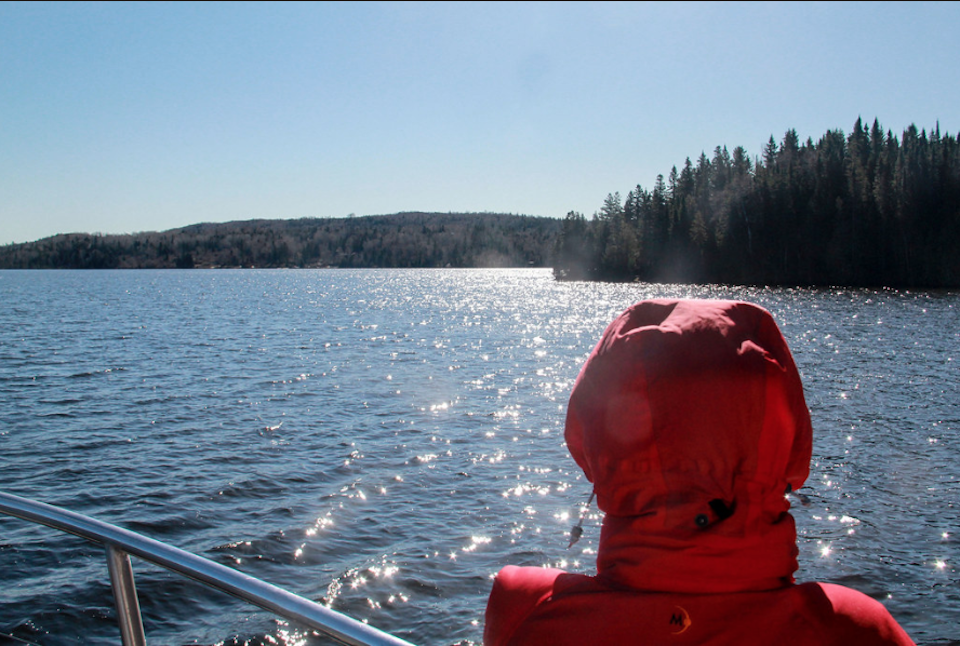
Approaching Isle Royale National Park/Robert Pahre
With the arrival of summer, the national parks begin to fill with RVs, minivans, SUVs, and tour buses. Fifty years ago, Americans in their wood-paneled station wagons might linger in a national park for a week or two, but today many visitors try to tag as many parks as possible on their too-short vacations.
Except at Isle Royale, that is.
Because it’s an island in the northwestern part of Lake Superior, there are no RVs, tour buses, or minivans – just some cabin cruisers and a lot of kayaks. Though Rock Harbor has a lodge and some cabins, most visitors camp. It’s hard to reach Isle Royale, so people tend to stay a while. This makes it the least-visited national park in the Lower 48 states.
Isle Royale also attracts many return visitors – indeed, my eldest son and I were on our third visit. The entire family had taken a trip when the kids were younger, including a backpacking trip along Rock Harbor. Those days were filled with thimbleberry collecting, short hikes, and brief dips in Lake Superior’s brutally-cold waters. A few years before that, Jay and I had explored the Feldtmann Ridge Loop on a three-day trip.
This time we planned to hike the length of the island and then come most of the way back. We arrived on the second boat of the season from Grand Portage, Minnesota, and returned before Memorial Day. Almost all of the park’s facilities were closed, though rangers and concessioner employees were busy getting things ready for summer visitors to arrive.
Isle Royale sounds like an island, but the park is really an archipelago of 400 small islands. This makes the park a mélange of land and water. The main island has hundreds of interior lakes and ponds, and dozens of major lakes. The National Park Service mostly manages this wilderness by boat.
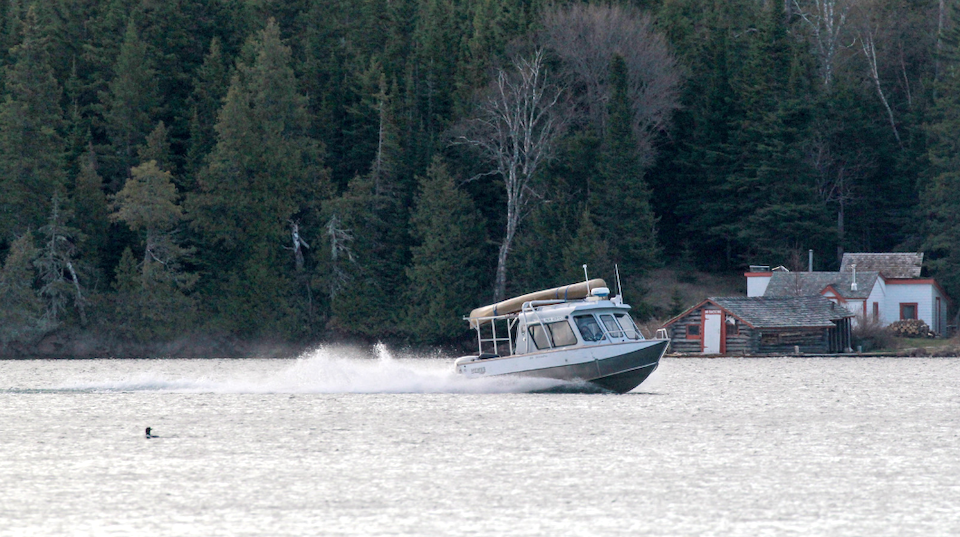
Boats greatly help the Park Service in patrolling and managing the park/Bob Pahre
Like most islands, Isle Royale has a distinctive mix of plants and animals because not every species on the mainland will make it across the water. The Park Service has management concerns about some species, such as bald eagles and the common loon, but most visitors want to see moose and wolves. Isle Royale provides critical habitat for wolves in the Lower 48, but they are newcomers to the island and only arrived in the 1940s.
In short, this kaleidoscope of land and water is full of surprises. Though its northern woods feel like untouched wilderness, second-growth forest covers most of the park. That growth has occurred since large-scale logging operations in the 1920s and 1930s, and after major wildfires in 1936. The island also has a rich Ojibwe (Anishinaabe) history that the National Park Service has tended to overlook. If you’re interested in that history, I heartily recommend Timothy Cochrane’s book Minong – The Good Place.
Despite those human histories, about 99 percent of the park now comprises a federally designated wilderness area. This classification came shortly after the Eastern Wilderness Act of 1975, which allows Congress to designate wildernesses with a history of human use. Though historic and cultural resources can remain, the park has often decided chosen to remove evidence of many past human uses. If you’re interested, Jessica Poirier and Richard Taylor’s book, Images of America: Isle Royale, collects photos of the Euro-American sites; Ojibwe hunting camps and sugar bush operations are all gone.
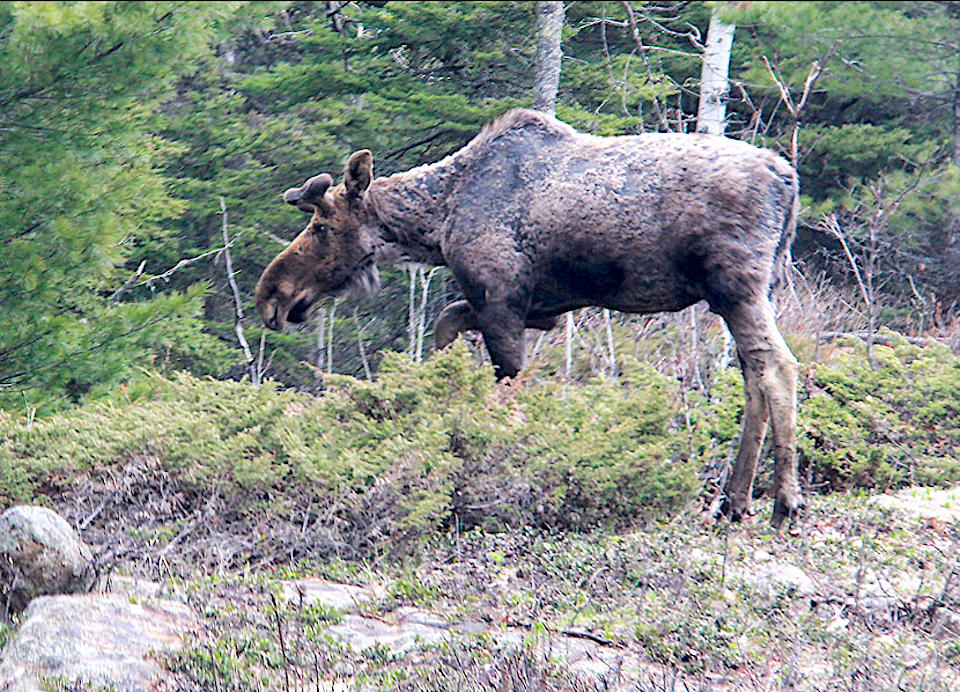
Moose on the Greenstone Trail at Isle Royale/Bob Pahre
The park has found it more difficult to remove evidence of historic copper mines, including some Ojibwe sites. On the busy side of the island around Rock Harbor, you can find mines on the Stoll Nature Trail and on the approach to Daisy Farm campground. On the north side, there are small mines near the campground at Todd Harbor. The largest historic mine, the Minong, has become a landscape of waste rock. You’ll find it on the Minong Trail, a short hike west of McCargoe Bay. The park has added fences around open mine pits, but mostly lets other evidence of historic mines fade away.
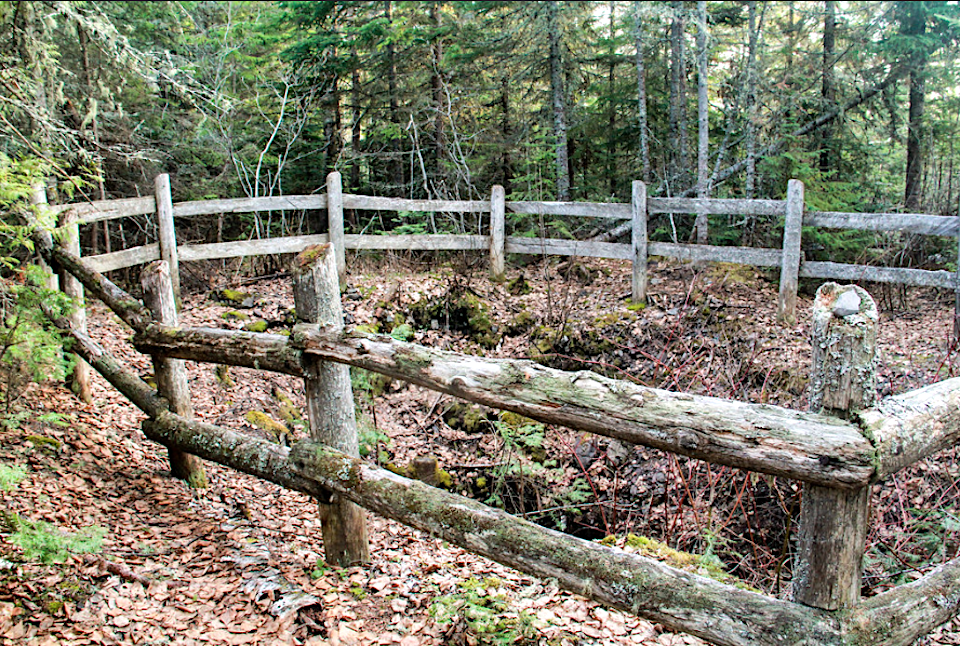
Todd Harbor Mine at Isle Royale/Robert Pahre
Removing evidence of people – other than modern tourists – is only part of how the Park Service actively manages “wilderness” here. It calls some of that management “rewilding,” often as an umbrella term for “ecological restoration.” This means that intervening in an ecosystem, instead of trying to preserve it “as is,” has often guided the park. That tension has dominated the much-debated decision to import wolves from Canada as the island’s own population dwindled to almost nothing. That decision preserves an unhistorical ecosystem, since both wolves and moose were 20th century arrivals. Overhunting seems to have been responsible for the loss of caribou, which the park does not plan to reintroduce. In contrast, snowshoe hares have survived hunting pressure from both human and non-human predators.
Wildlife remains one of the island’s major attractions. Though we neither saw nor heard wolves this time, we did see wolf footprints and scat on most days. We saw two moose along the trails, and one across Hatchet Lake. We also saw many snowshoe hares, red squirrels, garter snakes, a few beavers, an otter, and a fox. Bald eagles, sandhill cranes, Canada jays, loons, woodpeckers, and ducks were a regular part of our experience in addition to many songbirds. The aggressive Canada jays at Rock Harbor reminded us why my grandfather knew these birds as “camp robbers.”

A snowshoe hare in its summer pelage/Robert Pahre
As a remote wilderness park, Isle Royale’s policy challenges differ from those than in Yellowstone, Yosemite, or Great Smoky Mountains. While the “crown jewel” parks face urban challenges of traffic jams, air pollution, and overdevelopment, the recreational impact at Isle Royale is far less. It saw only 26,000 recreational visitors in 2018, far fewer than the several million visitors a year at the crown jewels.
Isle Royale sees almost as many backpackers as Yellowstone does, though Yellowstone is much larger and has far more miles of trail. In addition, Isle Royale’s visitors are crammed into a short season because the park closes for half the year. As a result, we saw more people in Isle Royale’s backcountry than we usually have when backpacking in Yellowstone.
This density makes it important to manage human impact effectively. A ranger greets you when you arrive on the island, and gives everyone a brief lesson in Leave No Trace principles. To keep both Lake Superior and the inland lakes clean, the park provides wilderness campgrounds with outhouses – a welcome luxury, I must confess.
While visitors notice the LNT training, and tend to appreciate the outhouses, most won’t notice the other ways managers try to reduce human impact. The Park Service has designed campgrounds and trails in ways that “nudge” visitor behavior without overt regulation or control. For example, Isle Royale’s campgrounds often keep vegetation between campsites for privacy and as a subtle way to keep campers on the intended paths.
Management also influences behavior by thinking strategically about how to distribute campgrounds around the island. The region around Rock Harbor has campgrounds spaced three to five miles apart, with a large number of shelters. This landscape serves families, novice backpackers, and those who prefer short-mileage days. For many reasons, those kinds of groups tend to have larger impacts on the environment. Concentrating them on a well-patrolled shoreline helps the park manage that impact.
In contrast, the Greenstone Trail spaces campgrounds to serve backpackers who want daily hikes of eight to twelve miles. We chose this option for our nine-day trip, with our first night at South Lake Desor. That makes Desor a natural destination for backpackers arriving at Windigo. We continued on the Greenstone to Hatchet Lake before cutting over to Todd Harbor for our second night. We continued to the end of the rocky Minong Trail at McCargoe Cove before crossing from the northwest side of the island to Rock Harbor on the northeast side. To plan your own trek, see Jim DuFresne’s Isle Royale National Park: Foot Paths and Water Routes.
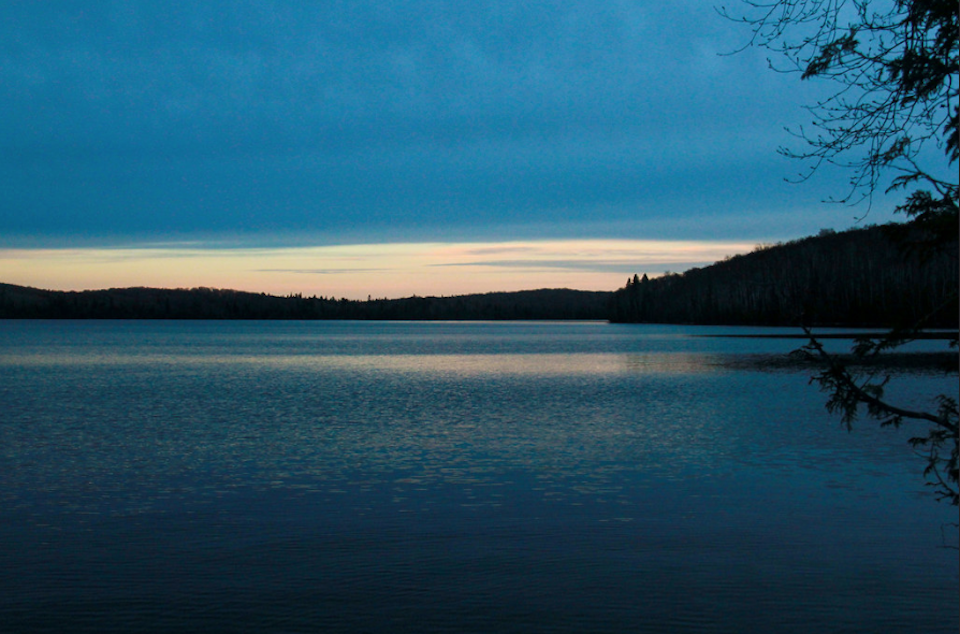
Lake Desor, Isle Royale National Park/Bob Pahre
The greater distances on the Greenstone and Minong trails mean that the interior of the island will see fewer campers, dispersed over wider areas. As a result, we met two different backpacker populations. On the first half of our trip, we mostly crossed paths with solo men (and one solo woman) who were regular visitors looking for long backpacking trips and relatively high mileage days. We met one man on his 65th trip to the island, and two more whose totals were in the dozens. Some regulars were returning to favorite places, while others were picking up trails and campgrounds they had not seen before. This group had lots of backpacking experience and a greater familiarity with LNT principles, characteristics that helps reduce human impact on the island’s interior.
On the second half of our trip, we met many more first-time visitors and couples. While they had dispersed by the time we reached them, we heard that 55 people had arrived in Rock Harbor on our Day 3. Many went to Daisy Farm on their first day. On their second day, they hiked a triangle-shaped loop along the Greenstone Trail before returning to their base at Daisy Farm. Daisy Farm is a highly developed site by Isle Royale standards, with 16 shelters, a boat dock, amphitheater, pavilion, and ranger station. Weirdly, it was also the only campsite we had to ourselves.
With everyone arriving by boat or seaplane, even a place that looks remote may attract a crowd. For example, Malone Bay looks like a remote destination at the end of the Ishpeming Trail, but it seems to be a popular place to catch the Voyageur II for the return to Grand Portage. That feature brought us there on our last night, and we took the last open shelter on our arrival. The next morning, we joined a happy band of backpackers on the dock to wait for our boat to emerge from the morning fog.
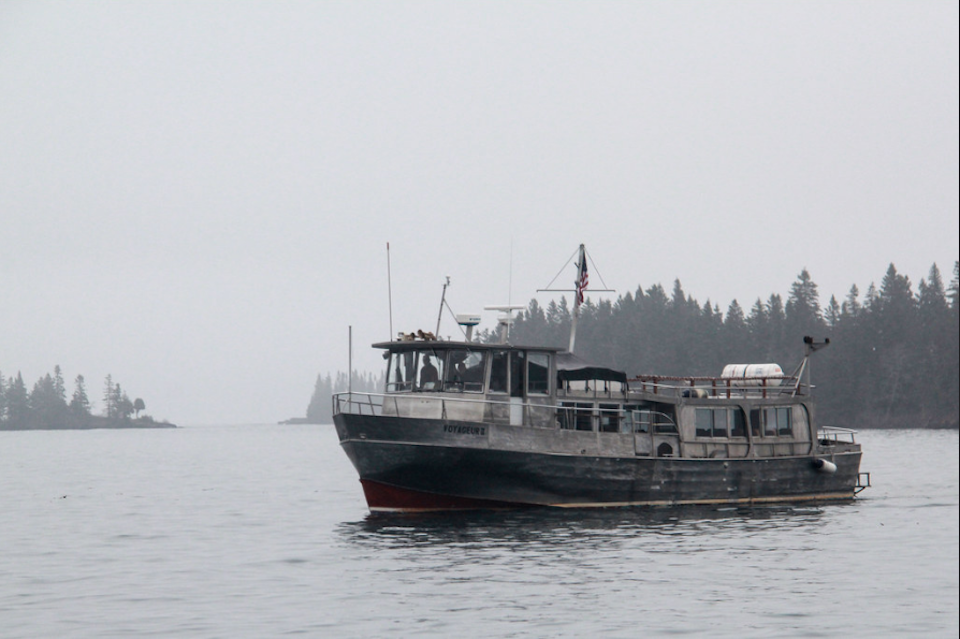
The old Voyageur II still plies Isle Royale's waters/Robert Pahre
Thanks to the park’s management strategies, natural sights and sounds filled our days and nights. The campgrounds near Rock Harbor offered the best sunrises, with the sun framed by the harbor. The north side of the island gave us the best sunsets, with clear views across the lake to the Ontario shoreline. Between sunset and sunrise, you can see a beautiful night sky away from urban lights—as long as the clouds cooperate.
You can also enjoy the sounds of wilderness. We fell asleep to a natural soundscape each night, and woke to that soundscape each morning. At Lake Ritchie, for example, we woke to a soundscape with barred owl, downy woodpeckers, loons, and a mix of songbirds. Sandhill cranes overhead dominated our time at East Chickenbone Lake.
Nature’s sounds help prepare you for educational messages when nature calls. The NPS posts some reading material on the inside of the outhouse doors. While otherwise disposed, you can read all about the local loon populations at Chickenbone Lake, Daisy Farm, Hatchet Lake, Malone Bay, Moskey Basin, and many other sites. Our outhouse at Rock Harbor reinforced lessons about Leave No Trace.
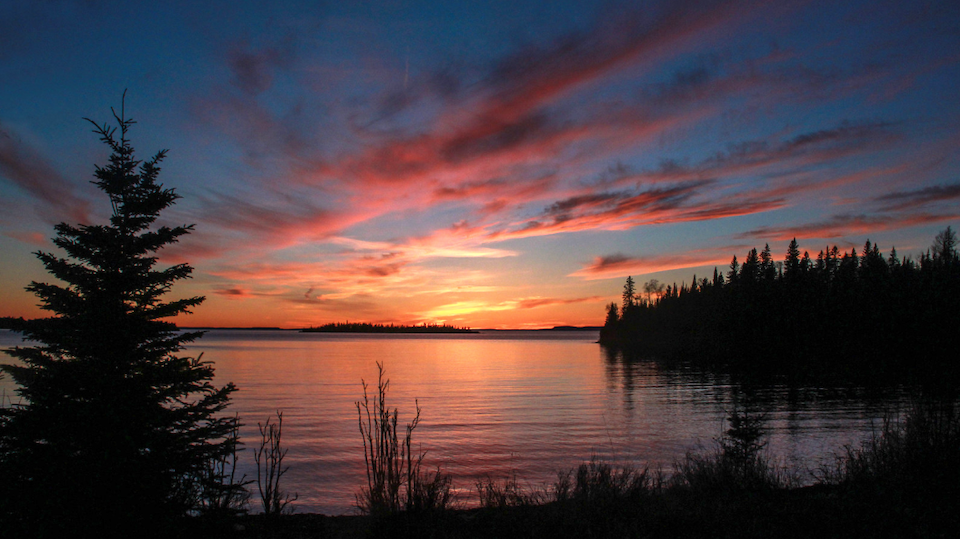
On the occasion of clear skies, sunsets can be incredible, like this one from Todd Harbor/Robert Pahre
The outhouse at Todd Harbor introduced new policy debates. A long-ago visitor wrote on the wall that he and a friend had destroyed dozens of cairns on the Minong Trail. They did this because “cairns are vandalism,” a common belief in some quarters. Someone else had responded with a graffito calling him a “tree huger” [sic], threatening to rebuild the cairns with his skull should they ever meet.
Perhaps the words of the prophets are written on the bathroom walls.
Whatever your view of cairns, we rarely wanted any. The only real navigation challenge came in a sugar maple forest where leaves still covered the trails, and the open woods didn’t provide much guidance. Blazes, not cairns, would have helped there.
The biggest hiking challenge was crossing downed trees before the trail crews could clear them. The Ishpeming Trail had a good mile of fallen trees along Lake Siskiwit, and another mile of occasional deadfall. We could go over or around all the downed trees, but it was slow going. I’m sure the trail crews stayed busy for many days here.
We also faced occasional challenges from the island’s beavers. We didn’t use a stretch of the Minong Trail famous for its three beaver dams, but we did have to cross a beaver dam on the Ishpeming Trail. We had to detour around a few more dams, and deal with soggy ground downstream from many more.
Winter storms, beaver dams, and a little route finding all make up part of the wilderness that people seek at Isle Royale. If deadfall and beaver dams sound a bit much for your taste, you can find a more relaxed experience along the trails from Rock Harbor to Moskey Basin. You’ll find campgrounds a few miles apart and a good number of three-sided shelters, with muddy trails your only real obstacle. Those who like a more challenging backcountry experience have many miles to explore.
Whatever you choose, Isle Royale offers a unique wilderness experience. With beautiful sunrises and sunsets, a dazzling night sky, and a natural soundscape, you can get far from the madding crowds where the North Woods mix with Lake Superior.
Suggested reading:
Timothy Cochrane, Minong—The Good Place: Ojibwe and Isle Royale. East Lansing: Michigan State University Press.
Jim DuFresne, Isle Royale National Park: Foot Trails & Water Routes, 4th edition. Michigantrailsmaps.com.
Jessica Poirier and Richard Taylor, Images of America: Isle Royale. Charleston, SC: Arcadia Press.
Robert Pahre is a professor of political science at the University of Illinois, where he teaches and writes about national parks and other public lands. You can find more of his photos of Isle Royale at https://www.flickr.com/photos/rpahre/albums/72157629038685205.



Comments
Great article, has me longing for a return trip to this enchanted place.
Thank you. This was a great story. I've always wanted to visit Isle Royale but doubt that I'll ever be able to do so. This story is the next best thing.
The fishing on the reefs is outstanding and sometimes the lake trout come in the harbor or inlets in the evenings looking for insects. Does the Isle Royal Queen aka The Barf Queen still run the short cut from Copper Harbor?
Thank you, Tammy. I'm glad you enjoyed both the island and the article.
Thank you for the kind comments, James. I hope that you surprise yourself and manage to make it to the island some time.
Thanks, Rudy. I've never fished at Isle Royale, nor have I taken the boats from Michigan. We have always left from Grand Portage, Minnesota.
Bob, how cold was it? We were on the North Shore of Lake Superior in late May. The winds coming off the lake were surprisingly cold. We wore winter down jackets when walking the break water out in the harbor of Grand Marais, MN with views out to Isle Royal in the horizon.
Owen, I would not be surprised if some nights dipped below 40, but I think most nights were in the low 40s. Mornings were chilly but pleasant, and warmed up. The days were mostly in the 50s, with sunny days probably giving us some in the 60s on the exposed ridges. Winds varied, and were strongest at Scoville Point (outside Rock Harbor) and on our last full day, a rainy hike with some winds on the Greenstone and strong winds at Malone Bay. In general, the interior sites were warmer, while camps on the south shoreline were colder and more exposed to the lake.
Everybody likes staying in the three-sided shelters, but obviously you don't have the warmth of a tent that way. I had a couple nights sleeping in fleece jackets with hat and gloves, but most nights did not require that. I was happy having available: an extra layer under my pants; a thin fleece and a thick one, wool hat and gloves, rain pants and a shell. Bring extra socks and sock liners because your boots will get wet on some days. I thought about bringing my winter sleeping bag, but was fine with a good three-season bag.
Our tent nights were comfortable even when it rained overnight (twice).